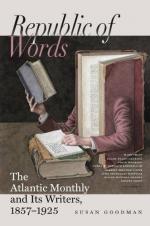But our renders must indulge us with one more quotation under this head, although we take it from one of the most popular—perhaps the most popular—of his poems, “The Death of the Flowers.”
“The wind-flower and the violet, they perished long ago, And the brier-rose and the orchis died amid the summer glow; But on the hill the golden-rod, and the aster in the wood, And the yellow sunflower by the brook in autumn beauty stood, Till fell the frost from the clear, cold heaven, as falls the plague on men, And the brightness of their smile was gone, from upland, glade, and glen. And now, when comes the calm mid-day, as still such days will come, To call the squirrel and the bee from out their winter home, When the sound of dropping nuts is heard, though all the trees are still, And twinkle in the smoky light the waters of the rill, The south-wind searches for the flowers whose fragrance late he bore, And sighs to find them in the wood and by the stream no more.”
Of the poetry of these exquisite lines, the melancholy sweetness of the sentiment, the delicate beauty of the versification, we need not say one word, but we claim a moment’s attention to their fidelity to truth, and the accuracy of observation which they evince. The golden-rod and the aster are the characteristic autumn flowers in that zone of our continent in which New England is embraced, and the sunflower is a very common flower at that season. That lovely child of the declining year, the fringed gentian, would doubtless have been brought in with her fair sisters, had it not been for her somewhat unmanageable name. Bryant has written some beautiful stanzas to this flower, but in them he only calls it a “blossom.” And how fine a landscape is condensed into the two delicious hues which we have Italicized! and yet no one ever walked into a New-England wood on a late day in autumn without hearing the nuts drop upon the withered leaves, and seeing the streams flash through the smoke-like haze which hangs over the landscape.
But winter, especially our clear and sparkling New-England winter, has its scenes of splendor and aspects of beauty; and the poet would not be true to his calling, if he failed to recognize them.
“Come when the rains
Have glazed the snow, and clothed the
trees with ice,
While the slant sun of February pours
Into the bowers a flood of light.
Approach!
The incrusted surface shall upbear thy
steps,
And the broad arching portals of the grove
Welcome thy entering. Look! the massy
Trunks are cased in the pure crystal;
each light spray,
Nodding and tinkling in the breath of
heaven,
Is studded with its trembling water-drops
That glimmer with an amethystine light;
But round the parent stem the long, low
boughs
Bend, in a glittering ring, and arbors
hide
The glassy floor.”




